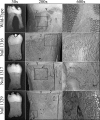Taurodontism, variations in tooth number, and misshapened crowns in Wnt10a null mice and human kindreds
- PMID: 25629078
- PMCID: PMC4299714
- DOI: 10.1002/mgg3.111
Taurodontism, variations in tooth number, and misshapened crowns in Wnt10a null mice and human kindreds
Abstract
WNT10A is a signaling molecule involved in tooth development, and WNT10A defects are associated with tooth agenesis. We characterized Wnt10a null mice generated by the knockout mouse project (KOMP) and six families with WNT10A mutations, including a novel p.Arg104Cys defect, in the absence of EDA,EDAR, or EDARADD variations. Wnt10a null mice exhibited supernumerary mandibular fourth molars, and smaller molars with abnormal cusp patterning and root taurodontism. Wnt10a (-/-) incisors showed distinctive apical-lingual wedge-shaped defects. These findings spurred us to closely examine the dental phenotypes of our WNT10A families. WNT10A heterozygotes exhibited molar root taurodontism and mild tooth agenesis (with incomplete penetrance) in their permanent dentitions. Individuals with two defective WNT10A alleles showed severe tooth agenesis and had fewer cusps on their molars. The misshapened molar crowns and roots were consistent with the Wnt10a null phenotype and were not previously associated with WNT10A defects. The missing teeth contrasted with the presence of supplemental teeth in the Wnt10a null mice and demonstrated mammalian species differences in the roles of Wnt signaling in early tooth development. We conclude that molar crown and root dysmorphologies are caused by WNT10A defects and that the severity of the tooth agenesis correlates with the number of defective WNT10A alleles.
Keywords: Familial tooth agenesis; hypodontia; oligodontia, taurodontism.
Figures







Similar articles
-
Candidate gene analysis of tooth agenesis identifies novel mutations in six genes and suggests significant role for WNT and EDA signaling and allele combinations.PLoS One. 2013 Aug 22;8(8):e73705. doi: 10.1371/journal.pone.0073705. eCollection 2013. PLoS One. 2013. PMID: 23991204 Free PMC article.
-
Abnormal primary and permanent dentitions with ectodermal symptoms predict WNT10A deficiency.BMC Med Genet. 2016 Nov 24;17(1):88. doi: 10.1186/s12881-016-0349-4. BMC Med Genet. 2016. PMID: 27881089 Free PMC article.
-
Involvement of and interaction between WNT10A and EDA mutations in tooth agenesis cases in the Chinese population.PLoS One. 2013 Nov 27;8(11):e80393. doi: 10.1371/journal.pone.0080393. eCollection 2013. PLoS One. 2013. PMID: 24312213 Free PMC article.
-
Patterns of Dental Agenesis Highlight the Nature of the Causative Mutated Genes.J Dent Res. 2018 Nov;97(12):1306-1316. doi: 10.1177/0022034518777460. Epub 2018 Jun 7. J Dent Res. 2018. PMID: 29879364
-
WNT10A, dermatology and dentistry.Br J Dermatol. 2021 Dec;185(6):1105-1111. doi: 10.1111/bjd.20601. Epub 2021 Sep 7. Br J Dermatol. 2021. PMID: 34184264 Review.
Cited by
-
Optineurin Cooperates With NRF2 to Regulate Tooth Root Morphogenesis by Controlling Mitochondrial Dynamics and Apoptosis.Cell Prolif. 2025 May;58(5):e13799. doi: 10.1111/cpr.13799. Epub 2025 Jan 6. Cell Prolif. 2025. PMID: 39762159 Free PMC article.
-
Full Spectrum of Postnatal Tooth Phenotypes in a Novel Irf6 Cleft Lip Model.J Dent Res. 2016 Oct;95(11):1265-73. doi: 10.1177/0022034516656787. Epub 2016 Jul 1. J Dent Res. 2016. PMID: 27369589 Free PMC article.
-
WNT10A variants in relation to nonsyndromic hypodontia in eastern Slovak population.J Genet. 2018 Dec;97(5):1169-1177. J Genet. 2018. PMID: 30555066
-
Genetic Evidence Supporting the Role of the Calcium Channel, CACNA1S, in Tooth Cusp and Root Patterning.Front Physiol. 2018 Sep 26;9:1329. doi: 10.3389/fphys.2018.01329. eCollection 2018. Front Physiol. 2018. PMID: 30319441 Free PMC article.
-
High prevalence of taurodontism in North China and its relevant factors: a retrospective cohort study.Oral Radiol. 2023 Apr;39(2):266-274. doi: 10.1007/s11282-022-00630-1. Epub 2022 Jun 30. Oral Radiol. 2023. PMID: 35771318
References
-
- Bae CH, Lee JY, Kim TH, Baek JA, Lee JC, Yang X, et al. Excessive Wnt/beta-catenin signaling disturbs tooth-root formation. J. Periodontal Res. 2013;48:405–410. - PubMed
-
- van den Boogaard MJ, Creton M, Bronkhorst Y, van der Hout A, Hennekam E, Lindhout D, et al. Mutations in WNT10A are present in more than half of isolated hypodontia cases. J. Med. Genet. 2012;49:327–331. - PubMed
Grants and funding
LinkOut - more resources
Full Text Sources
Other Literature Sources
Molecular Biology Databases

